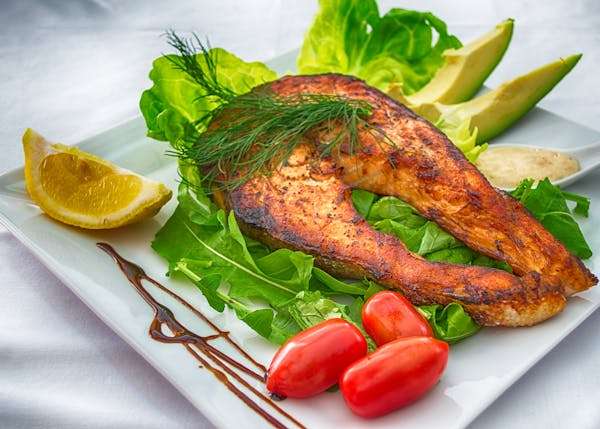In order to support the health of both the mother and the fetus, it is imperative to maintain a balanced diet during pregnancy. Seafood is a key part of a healthy diet since it is a great source of important nutrients like omega-3 fatty acids and high-quality protein.
However, not all seafood is created equal, which is why making the proper decisions is essential.
In this context, safe seafood for pregnancy plays a critical role in ensuring both you and your baby receive the maximum health benefits while minimizing risks.
This guide will help you understand which seafood choices are best for a healthy pregnancy and provide practical recommendations for incorporating them into your diet.
Why Seafood is Beneficial During Pregnancy:
Seafood is a powerhouse of essential nutrients, making it a highly beneficial addition to a pregnant woman’s diet. One of the primary benefits of seafood is its rich content of omega-3 fatty acids, particularly DHA (docosahexaenoic acid) and EPA (eicosapentaenoic acid).
These good fats improve cognitive function and visual acuity and are essential for the brain and ocular development of the developing infant. Seafood also offers high-quality protein, which is essential for mother and baby tissue growth and repair.
Seafood’s abundance of vital vitamins and minerals, including vitamin D, iodine, and selenium, is another noteworthy benefit. In order for the body to absorb calcium and support the growth of the baby’s bones and teeth, vitamin D is necessary.

Iodine promotes proper thyroid function, which is necessary for controlling metabolism and promoting the growth of the fetus. Because of its antioxidant properties, selenium helps to maintain healthy cells and a strong immune system.
When choosing seafood, it’s important to focus on safe seafood for pregnancy to avoid potential risks associated with mercury and other contaminants. By selecting low-mercury options and preparing them properly, pregnant women can enjoy the numerous health benefits of seafood while ensuring the safety of their growing baby.
Top Safe Seafood Choices for Pregnancy:
When selecting seafood during pregnancy, focusing on low-mercury options ensures both safety and nutritional benefits. Here are some top choices:

Salmon
- Nutritional Profile: Salmon is rich in omega-3 fatty acids, particularly DHA and EPA, which are vital for brain and eye development. Selenium, vitamin D, and high-quality protein are also provided by it.
- Health Benefits: The omega-3s in salmon support cognitive development and visual acuity in the baby. Vitamin D helps in calcium absorption, promoting healthy bone development. Additionally, selenium acts as an antioxidant, boosting the immune system.
Sardines
- Nutritional Profile: Sardines are packed with omega-3 fatty acids, protein, vitamin B12, and calcium. They are also a good source of vitamin D and selenium.
- Health Benefits: Sardines’ high omega-3 content supports fetal brain development and reduces the risk of preterm birth. The calcium and vitamin D in sardines contribute to strong bones and teeth for both mother and baby.
Trout
- Nutritional Profile: Trout offers a significant amount of omega-3 fatty acids, protein, vitamin B12, and potassium. It is also a good source of vitamin D.
- Health Benefits: Omega-3s in trout aid in the development of the baby’s brain and nervous system. Vitamin D supports bone health, while potassium helps in regulating blood pressure.
Shrimp
- Nutritional Profile: Shrimp is low in fat and calories, yet high in protein, vitamin B12, and iodine. It also provides selenium.
- Health Benefits: The high protein content helps in the growth and repair of tissues. Iodine is essential for thyroid function, and selenium provides antioxidant protection.
Catfish
- Nutritional Profile: Catfish is a good source of protein, omega-3 fatty acids, vitamin B12, and vitamin D.
- Health Benefits: The omega-3s in catfish support brain development and reduce inflammation. Vitamin D and B12 contribute to overall health and energy levels.

Choosing these safe seafood for pregnancy options ensures you receive the essential nutrients needed for a healthy pregnancy while minimizing exposure to harmful substances.
How to Choose Safe Seafood for Pregnancy:
Selecting the right seafood during pregnancy is crucial to ensure both nutritional benefits and safety. Here’s how to make informed choices:
- Opt for Low-Mercury Seafood: Mercury can harm fetal development, so it’s important to choose seafood with low mercury levels. Recommended options include salmon, sardines, trout, and shrimp. Avoid high-mercury seafood like shark, swordfish, and king mackerel, which can pose risks.
- Verify Source and Freshness: Always buy seafood from reputable sources that follow safety regulations. Fresh seafood should have a clean, ocean-like smell and firm, translucent flesh. Steer clear of shellfish with a slimy texture or a fishy scent.
- Follow Cooking Guidelines: Proper cooking eliminates potential pathogens and reduces risks. Ensure seafood is cooked to an internal temperature of 145°F (63°C). Avoid raw or undercooked seafood, such as sushi or ceviche, which can carry harmful bacteria or parasites.
- Check for Advisories: Stay updated on local and national seafood advisories that provide information on contamination levels and safety recommendations. This helps ensure that the seafood you consume is safe.
- Practice Portion Control: Even with safe choices, limit seafood consumption to 2-3 servings per week. This helps balance nutrient intake while minimizing potential exposure to contaminants.
By following these guidelines, you can enjoy the benefits of safe seafood for pregnancy while protecting your health and that of your baby.
Safe Seafood Cooking Tips:
Ensuring that seafood is safely prepared is essential for protecting both you and your baby from potential health risks. Here are key tips for cooking seafood safely during pregnancy:
- Cook Thoroughly: Seafood should be cooked to an internal temperature of 145°F (63°C). This temperature ensures that harmful bacteria and parasites are destroyed. With a fork, the flesh should be easily separated and opaque. Avoid eating raw or undercooked seafood, such as sushi or sashimi, as they can carry harmful pathogens.
- Avoid Cross-Contamination: Prevent cross-contamination by using separate utensils and cutting boards for seafood and other foods. Wash your hands, surfaces, and utensils with hot, soapy water after handling raw seafood to prevent the spread of bacteria.
- Proper Storage: Store seafood in the refrigerator at 32°F (0°C) or lower and use it within one to two days. For longer storage, freeze seafood at 0°F (-18°C). To prevent bacterial growth, thaw frozen seafood in the refrigerator rather than at room temperature.
- Check for Freshness: Fresh seafood should have a clean, ocean-like smell and firm, translucent flesh. Avoid seafood with a fishy odor or a slimy texture, as these are signs of spoilage.
- Avoid High-Risk Preparations: Be cautious with seafood preparations that may not ensure safety, such as smoked or pickled seafood. Opt for grilling, baking, steaming, or broiling to ensure thorough cooking.
Following this safe seafood for pregnancy cooking tips will help you enjoy the nutritional benefits of seafood while minimizing health risks for both you and your baby.
Foods to Avoid:
During pregnancy, it’s important to be cautious about seafood choices to avoid potential risks. Here’s what to watch out for:
- High-Mercury Seafood: Certain fish contain elevated levels of mercury, which can harm fetal development. Avoid seafood like shark, swordfish, king mackerel, and tilefish, as they have the highest mercury concentrations. Mercury exposure can negatively affect the baby’s brain and nervous system development.
- Raw or Undercooked Seafood: Raw seafood, such as sushi, sashimi, and ceviche, can carry harmful bacteria and parasites. Pregnant women should avoid these preparations to prevent infections like listeriosis or toxoplasmosis, which can pose serious risks to both mother and baby.
- Smoked Seafood: While smoked seafood can be a delicious treat, it may not always be safe. The smoking process doesn’t fully cook the fish, and some smoked varieties can contain harmful bacteria. Limit or avoid smoked seafood, especially if it’s not thoroughly cooked.
- Seafood from Unreliable Sources: Avoid seafood from sources that don’t follow safety regulations or don’t provide clear information about their sourcing practices. This can include seafood from contaminated waters or improper handling practices.
- High-Sodium Seafood: Some seafood products, like canned or processed varieties, can be high in sodium. Excess sodium can contribute to high blood pressure and fluid retention, which are particularly concerning during pregnancy.
Choosing safe seafood for pregnancy involves avoiding these high-risk foods to ensure both safety and health benefits while enjoying a balanced diet.
Conclusion:
In conclusion, incorporating safe seafood for pregnancy into your diet can offer significant nutritional benefits, supporting both your health and your baby’s development. By choosing low-mercury options, following proper cooking guidelines, and avoiding high-risk seafood, you can enjoy the advantages of seafood while minimizing potential risks.
Make informed choices and consult with your healthcare provider to ensure that your seafood selections contribute positively to a healthy pregnancy. Click to learn more.
FAQs:
- What types of seafood are considered safe during pregnancy?
Safe seafood options include salmon, sardines, trout, shrimp, and catfish. These choices are low in mercury and provide essential nutrients.
- How often can I eat seafood while pregnant?
It’s recommended to consume 2-3 servings of low-mercury seafood per week to balance nutritional benefits with safety.
- Is it safe to eat sushi during pregnancy?
It is best to avoid raw sushi during pregnancy due to the risk of bacterial and parasitic infections. Opt for cooked sushi options instead.
- What should I do if I’m unsure about the mercury levels in a seafood product?
Choose seafood from reputable sources that provide information about mercury levels. Avoid high-mercury fish and consult local advisories for updated information.
- How should I prepare seafood to ensure it’s safe to eat?
Cook seafood to an internal temperature of 145°F (63°C) until the flesh is opaque and flakes easily with a fork. Avoid undercooked or raw seafood to reduce the risk of contamination.
